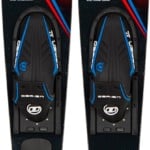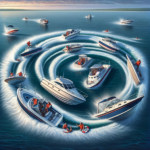So, you’ve just purchased a shiny new boat and you’re ready to hit the open waters. But before you take off on your aquatic adventures, it’s important to familiarize yourself with the best practices for handling boat propellers. After all, these powerful rotating blades are not to be taken lightly. From proper maintenance and storage to safe installation and operation, this article will guide you through the essential tips and tricks for handling boat propellers like a pro. So, let’s dive in and ensure that your boating experience remains enjoyable and accident-free!
Inspecting the Propeller
When it comes to handling boat propellers, it is essential to begin with a thorough inspection. By inspecting the propeller before use, you can ensure that it is in good working condition and identify any potential issues that may affect its performance.
Checking for Damage
One of the first things you should do when inspecting a propeller is to check for any signs of damage. Look for any nicks, dents, or cracks on the propeller blades. These damages can affect the overall performance of the propeller and may indicate the need for repairs or replacement.
Additionally, it is crucial to inspect the hub of the propeller. The hub should be securely attached to the propeller shaft and free from any signs of wear or damage. If you notice any looseness or play in the hub, it is recommended to consult a professional for further inspection.
Cleaning and Maintenance
Regular cleaning and maintenance of the propeller are essential for its longevity and performance. Before cleaning, make sure the boat engine is turned off and the propeller has completely stopped spinning. This will ensure your safety during the process.
Gently remove any debris or weeds that may have accumulated around the propeller blades. A soft brush or a plastic scraper can be useful tools for this task. Be cautious not to damage the propeller blades while cleaning.
After removing the debris, wash the propeller with fresh water to remove any saltwater residue or dirt. This will help to prevent corrosion and keep the propeller in top condition.
Checking for Loose Parts
Another crucial aspect of propeller inspection is checking for loose parts. Ensure that all bolts, nuts, and washers are securely fastened. Loose parts can cause vibrations and affect the performance of the propeller, potentially leading to more significant issues.
Carefully inspect the propeller shaft for any signs of damage or misalignment. A bent shaft can lead to vibration and excessive wear on the propeller blades. If you suspect any issues with the propeller shaft, it is recommended to consult a professional for a proper assessment.
Installing and Removing the Propeller
Proper installation and removal of the propeller are essential for ensuring safe and efficient boat operation. Following the appropriate procedures and using the correct tools and equipment will help prevent damages and accidents.
Using Proper Tools and Equipment
When installing or removing a propeller, it is crucial to use the appropriate tools and equipment recommended by the boat manufacturer or propeller manufacturer. This may include a prop wrench, prop puller, and other specialized tools.
Using the wrong tools or methods can lead to damage to the propeller or the boat’s engine system. It is always best to refer to the manufacturer’s guidelines or seek professional assistance if you are unsure about the correct tools or procedures.
Securing the Propeller
During the installation process, make sure to secure the propeller properly. Ensure that all bolts, nuts, and washers are tightened to the manufacturer’s specifications. Failing to secure the propeller adequately can lead to vibration, loss of performance, or even detachment during operation.
To avoid potential accidents, it is essential to be cautious when handling the propeller. The blades can be sharp, and any careless movements may result in injuries. Consider wearing gloves to protect your hands during installation and removal.
Removing the Propeller Safely
When it comes to removing the propeller, it is crucial to follow the proper safety procedures. Turn off the boat engine and allow the propeller to come to a complete stop before attempting to remove it. This will minimize the risk of accidental injuries.
Using a propeller puller can be beneficial in safely removing the propeller from the shaft. The puller provides leverage and helps to avoid damaging the propeller or the boat’s engine system.
Remember to store the propeller in a safe place when it is not in use. This will help prevent any damages or accidents and ensure that it is ready for the next boating trip.
Understanding Propeller Safety
Propeller safety is of utmost importance when it comes to boating. Being aware of the potential risks and taking the necessary precautions can prevent accidents and ensure the safety of everyone on board.
Wearing Personal Protective Equipment
Before operating or handling a boat propeller, it is crucial to wear appropriate personal protective equipment (PPE). This includes a life jacket, proper footwear, and eye protection.
A life jacket will provide flotation and ensure your safety in case of an accident or immersion in water. Proper footwear, such as non-slip boating shoes, will help to maintain grip and prevent slips or falls. Eye protection will shield your eyes from flying debris or splashes.
Keeping Hands Clear
When the boat’s engine is running, it is vital to keep your hands clear of the propeller at all times. The spinning blades can cause severe injuries and amputations.
Avoid reaching under or near the propeller, even when the engine is turned off. The blades may still be sharp, and accidents can occur if the propeller is accidentally rotated.
Locating Emergency Stop Switch
Familiarize yourself with the location and operation of the emergency stop switch, also known as the kill switch. This switch is designed to immediately stop the engine in case of an emergency or if someone falls overboard.
Knowing how to quickly access and activate the emergency stop switch can potentially save lives and prevent further accidents or injuries.
Handling Propellers in the Water
Handling propellers in the water requires extra caution and awareness of the surroundings. By following specific guidelines, you can minimize the risk of accidents and ensure the safety of everyone involved.
Avoiding Contact with Underwater Obstacles
When navigating in shallow or unfamiliar waters, it is crucial to be mindful of underwater obstacles, such as rocks, logs, or coral reefs. These obstacles can cause damage to the propeller and potentially harm the boat and passengers.
To avoid contact with underwater obstacles, proceed at a slow speed and maintain a vigilant lookout for any signs of potential hazards. If necessary, use navigation aids, such as charts or GPS, to identify and avoid areas with shallow depths.
Navigating in Shallow Water
When operating in shallow water, it is essential to adjust your boat’s trim and tilt settings to prevent the propeller from striking the bottom. Striking the bottom can cause significant damage to the propeller blades or the lower unit of the boat’s engine.
Maintain a safe distance from the bottom by adjusting the outboard motor’s trim and tilt settings accordingly. Being cautious and observant when navigating shallow water will help prevent costly repairs and ensure a smooth boating experience.
Being Cautious Near Swimmers
If there are swimmers in the water, it is crucial to exercise caution and maintain a safe distance from them. Always be aware of your surroundings and keep an eye out for any swimmers in the vicinity.
Reduce your speed when approaching areas where swimmers may be present. Ensure that the boat’s propeller is a safe distance away from anyone in the water to prevent any accidental contact or injuries.
Maintaining Proper Propeller Balance
A well-balanced propeller is essential for optimal performance and smooth operation. Imbalance can lead to vibrations, decreased efficiency, and excessive wear on the boat’s engine system. Regularly checking and maintaining the propeller’s balance is necessary to avoid these issues.
Checking for Imbalance
To check for propeller imbalance, visually inspect the propeller blades and hub for any signs of uneven wear. Uneven wear patterns, such as excessive material removal from specific spots, can indicate an imbalance.
If you suspect an imbalance, consider using a propeller balancing tool or consult a professional for a more accurate assessment. Balancing the propeller will help minimize vibrations and ensure efficient and safe operation.
Balancing Techniques
There are various techniques used to balance propellers, depending on the type and severity of the imbalance. One common method is the addition of small weights to the lighter side of the propeller. This helps to achieve balance and reduce vibrations.
Balancing a propeller requires precision and accuracy. It is recommended to seek professional assistance or refer to the manufacturer’s guidelines for specific instructions on balancing techniques suitable for your propeller.
Seeking Professional Help
If you are unsure about how to balance a propeller or suspect significant imbalance, it is advisable to seek professional help. Experienced propeller technicians have the expertise and specialized tools needed to accurately diagnose and correct any propeller imbalances.
Professional propeller balancing services can ensure that the propeller is properly balanced, leading to improved performance, reduced vibrations, and increased longevity of the propeller and boat’s engine system.
Avoiding Propeller Entanglement
Propeller entanglement accidents are a serious concern when it comes to boating safety. Taking preventative measures and implementing safety precautions can greatly reduce the risk of entanglement and ensure the safety of everyone on board.
Educate Passengers and Crew
One of the first steps in avoiding propeller entanglement is to educate all passengers and crew members about the dangers associated with the propeller. Emphasize the importance of staying away from the propeller area and avoiding any loose clothing or accessories that can get caught in the spinning blades.
Ensure that all passengers and crew understand the potential risks of propeller entanglement and know what actions to take to avoid it. Encourage open communication and a safety-oriented mindset among everyone on board.
Staying Alert
Remaining alert and vigilant when the boat’s engine is running is crucial in avoiding propeller entanglement accidents. Designate a spotter if necessary, whose primary responsibility is to keep an eye on the area around the propeller and alert the operator if there is any potential danger.
Be mindful of the presence of swimmers, divers, or any floating debris in the water. Make sure to maintain a safe distance from these individuals or objects to prevent accidental entanglement.
Implementing Safety Shut-Off Devices
Installing safety shut-off devices can provide an added layer of protection against propeller entanglement accidents. These devices are designed to immediately stop the boat’s engine if someone falls overboard or is pulled into the propeller area.
There are different types of safety shut-off devices available, such as lanyards or wireless sensors. Ensure that the device is properly installed and functioning correctly before operating the boat. Regularly check and maintain these devices to ensure their effectiveness.
Preventing Foul Weather Damage
Foul weather conditions can pose additional challenges and risks when it comes to handling boat propellers. Implementing the following practices can help minimize potential damages and ensure safety during adverse weather conditions.
Taking Precautions in Strong Winds
In the presence of strong winds, it is crucial to take additional precautions to protect the propeller and the boat. Reduce your boat’s speed and adjust the trim and tilt settings to maintain stability in high winds.
Avoid operating the boat in areas with shallow water or strong currents during strong winds. These conditions can make it difficult to maneuver the boat and increase the risk of propeller damage or accidents.
Navigating Rough Seas
When navigating in rough seas, it is essential to modify your boating techniques to minimize potential damage to the propeller. Reduce your boat’s speed and maintain a cautious approach to navigating through the waves.
Steer clear of large swells or breaking waves that can cause excessive strain on the propeller. Instead, aim to navigate through calmer areas to ensure the safety of your propeller and avoid any unnecessary wear or damage.
Securing the Propeller when Storm Approaches
When foul weather is approaching, it is recommended to secure the propeller to protect it from potential damage. Use a propeller cover or remove the propeller and store it in a safe place until the storm passes.
Securing the propeller will help prevent any debris or objects from impacting the blades during the storm. It is crucial to ensure that the propeller is properly stored and protected to avoid any potential damages.
Maintaining Propeller Efficiency
To ensure optimal performance and efficiency, it is important to maintain the propeller regularly. By following these practices, you can maximize the propeller’s lifespan and enjoy smooth and enjoyable boating experiences.
Regular Cleaning and Inspection
Regular cleaning and inspection of the propeller are crucial to maintaining efficiency. Remove any debris, seaweed, or marine growth that may have accumulated on the blades. This will help improve the propeller’s performance and prevent unnecessary strain on the boat’s engine.
Inspect the propeller for signs of damage, such as chips, cracks, or bent blades. If you notice any issues, consider consulting a professional for repairs or replacement. Addressing these issues promptly can prevent further damage and ensure the longevity of the propeller.
Maintaining Proper RPM
Maintaining the propeller’s RPM (revolutions per minute) within the manufacturer’s recommended range is essential for efficient performance. RPM that is too low can result in poor acceleration and decreased fuel efficiency, while RPM that is too high can cause excessive strain on the propeller and the boat’s engine.
Regularly monitor and adjust the boat’s throttle to maintain the propeller’s RPM within the recommended range. This will help optimize the propeller’s efficiency and ensure smooth operation.
Retaining Blade Sharpness
The sharpness of the propeller blades plays a crucial role in the overall performance and efficiency. Over time, the blades may become dull due to wear or contact with underwater obstacles.
Maintaining the sharpness of the propeller blades can be achieved through professional blade sharpening services. These services help restore the optimal sharpness and performance of the propeller, ensuring maximum efficiency and reducing the strain on the boat’s engine.
Understanding Propeller Laws and Regulations
Being knowledgeable about propeller laws and regulations is essential for responsible boating. Different regions and bodies of water may have specific rules and restrictions related to propeller operation. Adhering to these regulations helps protect the environment and ensure the safety of all individuals on the water.
Knowing Local Boating Rules
Before heading out on the water, familiarize yourself with the local boating rules and regulations applicable to your area. These rules can vary depending on factors such as waterbody type, boat size, and activities permitted.
Local boating rules may include speed limits, no-wake zones, and restrictions on certain areas or times. By understanding and following these rules, you can help maintain a safe and enjoyable boating environment for everyone.
Understanding Propeller Zone Restrictions
Certain areas may have propeller zone restrictions in place to protect sensitive habitats or marine life. These restrictions often include no-entry or go-slow zones where propeller operation is limited or prohibited.
It is important to be aware of these restrictions and avoid entering or operating in designated propeller zones. By respecting these regulations, you contribute to the preservation of delicate ecosystems and wildlife habitats.
Complying with Wildlife Protection Regulations
Many regions have specific wildlife protection regulations in place to safeguard marine animals, including sea turtles, manatees, and dolphins. These regulations often require boaters to maintain a safe distance from these animals to prevent harm or disturbance.
Educate yourself about the wildlife protection regulations in your area and follow the guidelines provided. Staying at a safe distance from wildlife and avoiding propeller strikes or disturbances helps protect these animals and their natural habitats.
Training and Education
Continuous training and education are fundamental for safe and responsible boating practices. By investing in your boating knowledge and skills, you can ensure a lifetime of enjoyable and incident-free experiences on the water.
Taking Boating Safety Courses
Participating in boating safety courses is a great way to enhance your knowledge and acquire essential skills. These courses cover various topics, including proper propeller handling, navigation techniques, emergency procedures, and boating laws and regulations.
By completing boating safety courses, you gain valuable insights into best practices and develop the necessary skills to navigate the waters safely.
Learning from Experienced Professionals
Learning from experienced boaters and professionals in the industry can provide valuable firsthand knowledge and guidance. Seek opportunities to go boating with experienced individuals who can share their expertise and help you improve your techniques.
Engage in conversations with experienced professionals at marinas, boating clubs, or industry events. Ask questions and absorb their advice to enhance your understanding of propeller safety and operation.
Staying Up-to-Date with Industry Knowledge
The boating industry evolves continually, with advancements in technology, safety measures, and regulations. It is important to stay up-to-date with the latest industry knowledge and developments to ensure that you are practicing the most current and effective propeller handling techniques.
Stay informed by reading boating magazines, following industry-related websites, or attending boating expos and seminars. By staying knowledgeable about the latest trends and advancements, you can enhance your propeller handling skills and ensure safe boating practices.
In conclusion, handling boat propellers requires careful attention to detail and adherence to best practices. By inspecting propellers for damage, using proper tools and equipment, and following propeller safety guidelines, you can minimize the risk of accidents and ensure safe and enjoyable boating experiences. Additionally, maintaining proper propeller balance, avoiding entanglement, and following specific procedures during foul weather conditions are crucial for propeller longevity and safety. Familiarizing yourself with propeller laws and regulations, investing in training and education, and staying current with industry knowledge will help you become a responsible and proficient boater.





